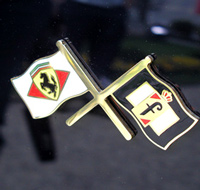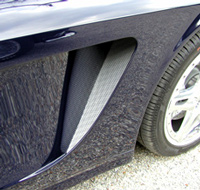Peter Kalikow is one of the most famous car collectors in the United States and his personal collection consists primarily of vintage Ferraris.
But earlier this year, Kalikow took delivery of a rebodied 612 Scaglietti, which was specifically designed for him by Pininfarina. The new Ferrari, named the “612 K”,
Debuted at the Ville D’Este event last spring, and in August was shown at Pebble Beach.
Last month we had a chance to talk with Mr. Kalikow and view the new car in detail.
(Click here for an interview with designer Jason Castriota.)
VT: After years of all quiet on the coach building front (with the exception of the Sultan of Brunei’s somewhat secretive efforts of the years), suddenly we have the Glickenhaus P4/5, Giugiaro’s interpretation for his own pleasure, Zagato’s GTZ for a Japanese client, and of course the Kappa.
Is this a resurgence of the great coach building era circa 1945-1975?
PK: Yes and no. Yes, in that there is a great deal of interest by customers as well as a willingness of the custom coach building to do a customer one-off. No, because these projects tend to be very expensive and different homologation rules in various countries require a great deal of paperwork to make the cars road legal. So I think that we will see some of these customs, but not nearly at the level that we saw during the 30 years following World War II.
VT:If so, why now? Is it still not cost prohibitive?
It is very expensive to do, but remember – there is a lot of money in the hands of enthusiasts. Special cars seem to have a great deal of value to people and as long as this affluence allows people to pay $250k for a muscle car, I think you will still find a small but interesting market for these special cars.
VT:What are the factors that have caused this new interest in personal coach building?
I think people who buy Ferraris, Maseratis, Lamborghinis, Rolls Royces and Bentleys are sometimes not satisfied with the individuality created by the “production model” and they seek individuality in other areas. Like a custom made suit – made for you – no one else has it – and it’s very special.
VT: According to a recent article on the Internet, your instructions to Pininfarina’s Special Projects were:
“The car should be totally rebodied but the style changes should be so slight and fine to allow that no more than 10% of Ferrari experts to catch them at first glance.”
Is this correct?
Yes, it is correct.
VT: Why go to the expense of a total rebody and then incorporate only “slight and fine” styling changes?
I like the 612. I think it is, for my use, the best Ferrari ever created. There were just some areas on the body I did not like. I had remembered a special Lusso, S/N 4335 and a special 275-GTB S/N 6437. These cars were essentially styling revisions of existing beautiful models and when I got into the project with Pininfarina, I suggested that I wanted these slight modifications because I was not totally happy with the look of the standard 612. As it turned out, in order to meet Pininfarina’s high standards of body surfacing and styling, all new panels (except the trunk lid) needed to be created.
As the final result proves, they were right because many of the details around the fenders as well as the aft deck, work in great harmony but could only have been done by making entirely new panels.
VT:Was your participation in the project at arm’s length or did you often travel to Turin to check on the progress of the project?
Because of modern technology, I was able to receive essentially daily emails presenting questions or problems that needed to be solved. I did make 3 or 4 trips to Torino because I’m a firm believer in touching and feeling, but they were more for my own gratification then as a necessity. Additionally, DHL and FedEx would send packages and documents within one or two days.
In the 50s and 60s, this project would have been done only with a client spending a great deal of time (probably weeks) in Italy. The good thing about living today is that with all the emails, jpgs, etc. We get instant information but we miss the great food.
VT:Did you establish a personal relationship with Jason Castriota, and if so, how did this affect the final outcome of the design?
I had a great personal relationship with Jason. I though it was very important to the process and I was amazed that such a young person had the same feel for the old traditions, as I did.
VT: How did your love of vintage Ferraris affect your thoughts on the Kappa?
Many years ago I was honored to know William Mitchell of General Motors and it was his theory that automobiles should have a lineage dating back to its earliest beginnings as a brand. These are usually effected by styling clues and certain thematic endeavors. In creating the Kappa, we relied on some areas going back to the 50’s, some as recent as the Enzo, as well as new technology in the roof, communication and navigation. So, I think that the Kappa is the best of the old and the best of the new.
VT: The hood scoop is reminiscent of those of the 250GT Cabriolet. Was that your idea?
The hood scoop to me was a very traditional Ferrari element. The first Ferrari that I ever saw was a 1958 Pininfarina Cabriolet. To my mind the hood scoop was an important part of every Ferrari and I was happy when Ferrari reintroduced it on the Maranellos. I added it to the Kappa because even though the traditional 2+2 Ferraris never had the hood scoop, my idea of the 612 was that it was based on the 410 Superamerica which definitely did have a hood scoop. So, I guess you could say that it was one of my styling briefs and that I am glad it worked so well.
VT: The glass top is interesting yet a bit mysterious --what are functions of the liquid crystals and photoelectric cells?
The roof is all glass. There is a complete line of glass from the base of the windscreen to the trunk lid, incorporating the windscreen, the back window and the roof. Going back more than 40 years, it was traditional for some custom Ferraris to have fixed glass roof panels with interior shades. We just brought this idea up to the 21st century by having glass roof panels and shades but also adding photo luminescent electronics that allow us to vary the light coming in and a center section with photovoltaic function, which uses the sun’s energy to create electricity. The system operates exhaust fans that exit hot air out of the passenger compartment when the car is parked and left standing in the sun. The system shuts off immediately when the ignition is turned on. I think it is useful and it adds some 21st century technology to the car.
VT: There are very small Dino-like “buttresses” incorporated into the rear of the car. Very neat---which of the earlier Pf designs motivated this design feature?
The rear buttresses are a very interesting styling technique. They came about as Pininfarina’s solution to my problem with the length of the 612’s rear section. These buttresses turn the car from a three volume design (engine – passenger compartment – trunk) to a two volume design (engine – passenger compartment). The overall visual effect of the buttresses along with beefier rear fenders is to visually shorten the car and create a more muscular feel.
VT: Can you tell us more about the interior features or devices, and which ones you are particularly fond of?
All of the interior features were specifically designed to enhance my driving comfort and pleasure.
I. Starter Button -- a starter button replaces the ignition key starter function, giving a nice retro/race car feel, but it is installed in a place which cannot be seen by the passengers, so it is sort of private to me.
II. Horn -- because I am sometimes guilty of excess horn usage, Pininfarina created a two horn system - a low volume regular horn for the city and a high volume air-horn for the highway.
III. Seats -- my seats have two features not normally found on Ferraris. The first is a manual thigh bolster extender. The second is electronically controlled side bolsters on the back section. These along with the normal Ferrari functions like power adjusting, lumbar and heating give me a great seat for long distance driving.
IV. Telephone – Pininfarina installed a Becker unit which in addition to being a radio/cd-changer/navigation system, is also an integrated telephone using the GSM-SIM card system. There is also a privacy handset for use by my passenger when they make calls so that I am not distracted from my favorite thing, which is driving.
V. Garage Door Opener – Pininfarina installed a HOMELINK automatic gate opener in the ceiling which I believe came from a Lexus sun visor.
VI. Roof – in addition to having electric shades, it has a multi position for allowing light through and a photovoltaic center section as we described before.

|

|
VT: Now that the project is over, what did you and the designer, Jason, gain from the project in terms of experience and satisfaction?
The experience I gained is that both Ferrari and Pininfarina are exceptionally capable firms who’s desire is both to please their customer and create products which bring the driving experience to a level not achieved by any other company. The satisfaction I get is driving the car and looking at it.
VT: Can you update us on your current collection of Ferraris--if not all, then at least your favorites?
As you know I have been a Ferrari customer for 39 years and have a collection of many Ferraris. My favorites are the late 50’s and early 60’s models. The cars I use on a pretty regular basis are my Californias (LWB and SWB) and of course my 400 Supermerica Aerodinamica.



